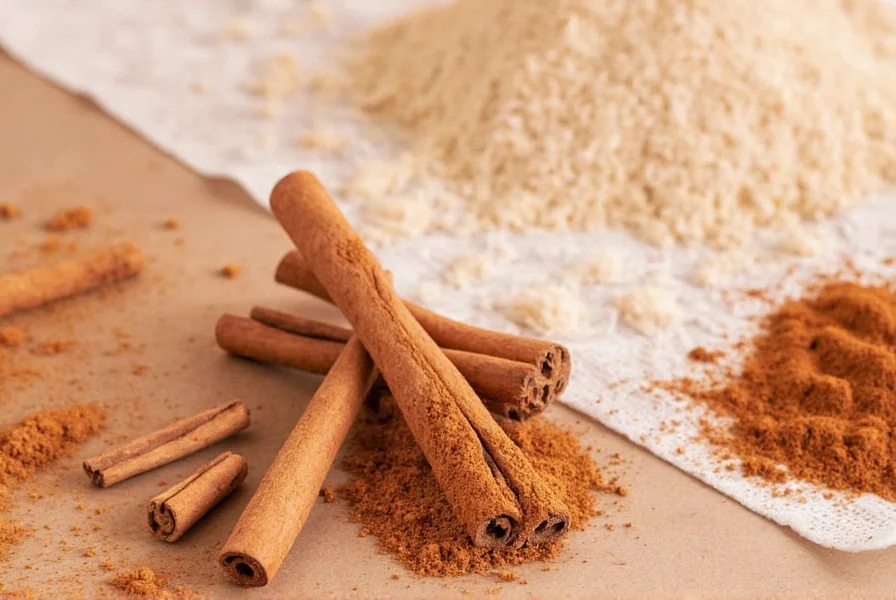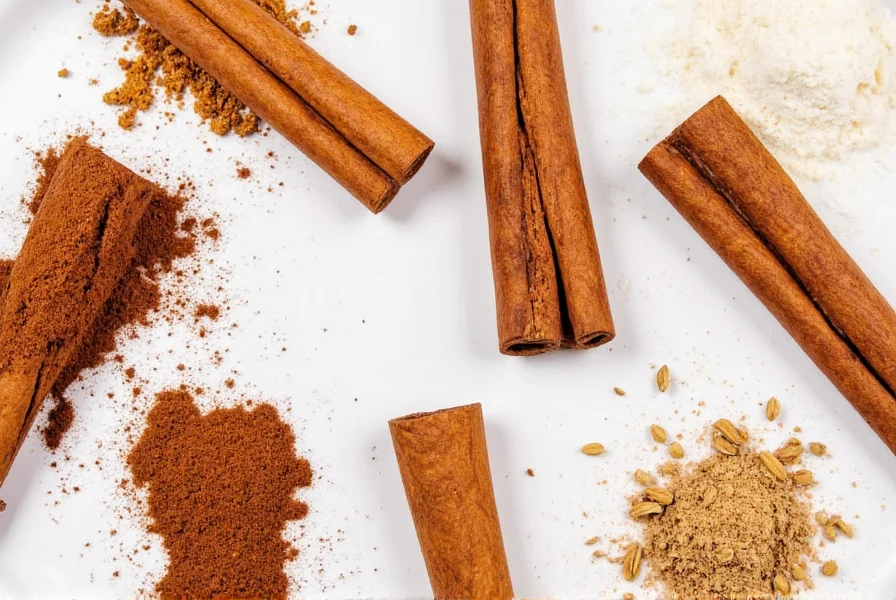No, cinnamon is not sawdust. It's made from the inner bark of cinnamon trees, but its fibrous texture can resemble sawdust. However, cinnamon is a safe, aromatic spice with distinct properties that set it apart from wood debris. In this article, we'll explain why this misconception exists, how to identify real cinnamon, and tips for choosing high-quality products.
- Why Does Cinnamon Look Like Sawdust?
- Types of Cinnamon: Not All Are Created Equal
- Sensory Comparison: Cinnamon vs. Sawdust
- How to Test Real Cinnamon at Home
- Buying Guide: Choosing Quality Cinnamon
- Cooking with Cinnamon: Tips and Tricks
- Fun Facts About Cinnamon
- Frequently Asked Questions
Why Does Cinnamon Look Like Sawdust?
The answer lies in what cinnamon actually is. Cinnamon is made from the inner bark of several trees in the genus Cinnamomum. When harvested, the bark is dried and either rolled into sticks or ground into powder. The texture of both forms is naturally fibrous and dry — which gives it that sawdust-like appearance.
However, unlike sawdust, cinnamon contains aromatic oils and compounds like cinnamaldehyde, which give it its signature scent and flavor. These volatile oils evaporate over time, leaving behind more of the woody texture and less of the aromatic punch.
The Role of Cinnamaldehyde
| Compound | Role in Cinnamon | Concentration (%) |
|---|---|---|
| Cinnamaldehyde | Main aroma compound | 50–90% |
| Eugenol | Antiseptic and antioxidant properties | 2–8% |
| Linalool | Floral note in aroma | 1–4% |
Types of Cinnamon: Not All Are Created Equal
Not all cinnamon is the same — and understanding the different varieties can help clear up the confusion about its sawdust reputation. Let's take a look at the two most common types:
Ceylon vs. Cassia Cinnamon
| Type | Origin | Texture | Taste | Price |
|---|---|---|---|---|
| Ceylon | Sri Lanka | Fine, light brown powder; thin, layered sticks | Delicate, citrusy | Premium |
| Cassia | China/Indonesia | Darker, coarser powder; thick, rigid sticks | Strong, spicy | Budget-friendly |

Sensory Comparison: Cinnamon vs. Sawdust
To understand why people might say "cinnamon is sawdust," we can break down a sensory comparison:
- Touch: Both feel dry, gritty, and fibrous.
- Sight: Cinnamon is brownish-red; sawdust varies by wood but often similarly beige or brown.
- Smell: Here's where the difference shines — cinnamon smells warm, sweet, and spiced, while sawdust is earthy and neutral at best.
- Taste: Obviously, you don't eat sawdust. But if you do a tongue test with real cinnamon, it should tingle slightly and leave a lingering warmth.
In short: visually and texturally, they can seem similar. But chemically and experientially, they couldn't be more different.
How to Test Real Cinnamon at Home
Worried you might be getting low-quality or even fake cinnamon? Try these simple tests:
- The Water Test: Sprinkle a small amount of cinnamon into a glass of water. If it sinks immediately and clumps together, it might be Cassia. If it floats and disperses slowly, it could be Ceylon.
- The Smell Test: Rub a bit between your fingers. Authentic cinnamon should have an immediate, warming aroma.
- The Tongue Test: Place a pinch on your tongue. It should produce a tingling heat and sweet-spicy flavor. If it feels overly bitter or harsh, it may be adulterated or old.
- The Oil Stain Test: Mix cinnamon with a spoonful of olive oil. True cinnamon will leave a reddish stain due to natural pigments.
Buying Guide: Choosing Quality Cinnamon
Choosing good cinnamon doesn't have to be complicated. Here's what to look for when shopping for either sticks or powder:
Top 5 Cinnamon Products Worth Trying
| Product | Features | Advantages | Best For | Occasions |
|---|---|---|---|---|
| Ceylon Organics Cinnamon Powder | Organic, fine texture, pure Ceylon | Mild, versatile, low coumarin | Health-conscious users, baking lovers | Teas, smoothies, delicate desserts |
| Spice Islands Ground Cinnamon | Consistent grind, affordable | Great everyday value | General cooking, baking | Oatmeal, pancakes, baked goods |
| Bobs Red Mill Cinnamon Sticks | Natural, unbroken sticks | Reusable, great for infusing flavors | Coffee, tea, stews | Gifts, simmer pots, mulled wine |
| Frontier Co-op Organic Ceylon Cinnamon Sticks | Thin, curling bark layers | Premium quality, elegant presentation | Fancy cocktails, gourmet dishes | Special occasions, dinner parties |
| Kalustyan's Indonesian Cassia Cinnamon | Thick, bold sticks | Intense flavor, perfect for hearty dishes | Meat rubs, soups, rice dishes | Everyday cooking, rustic meals |
What to Look For
- Packaging: Airtight containers preserve flavor better than open bags.
- Country of Origin: Sri Lanka (Ceylon), China/Indonesia (Cassia).
- Expiration Date: Spices lose potency after a year — check for freshness.
- Ingredient List: Should only list 'cinnamon' — no fillers or additives.
Cooking with Cinnamon: Tips and Tricks
Cinnamon is one of the most versatile spices in the kitchen. Whether you're baking apple pie or simmering a Moroccan stew, here are some ways to get the most out of your cinnamon:
- Bake Smart: Use Ceylon for delicate pastries and cakes; Cassia for heartier pies and cookies.
- Rub It In: Add a dash to meat rubs — especially lamb, duck, and pork.
- Infuse Drinks: Simmer sticks in coffee, chai, or hot cider for rich depth of flavor.
- Balance Flavors: In savory dishes, a pinch of cinnamon can add warmth without sweetness.
- Pair Wisely: Works beautifully with nutmeg, cardamom, vanilla, apples, chocolate, and oranges.
Fun Facts About Cinnamon
- Cinnamon was once worth more than gold in ancient times.
- The Egyptians used it for embalming and preserving bodies.
- Cinnamon has natural antimicrobial properties and can help regulate blood sugar levels.
- A single tree can yield bark for up to 40 years.
- Cinnamon was among the first spices traded globally, dating back over 4,000 years.
Frequently Asked Questions
Is cinnamon really just sawdust?
No, cinnamon is not sawdust. While they share some visual and textural similarities because cinnamon is made from tree bark, they are completely different substances. Cinnamon contains aromatic compounds like cinnamaldehyde that give it its distinctive flavor and smell, whereas sawdust is simply wood debris with no culinary value.
Why does cinnamon look like sawdust?
Cinnamon looks like sawdust because it's made from the inner bark of cinnamon trees. When this bark is dried and ground, it creates a fibrous, dry powder that can resemble fine sawdust. However, real cinnamon will have a distinctive sweet-spicy aroma that sawdust lacks.
How can I tell if my cinnamon is real and not adulterated?
You can test cinnamon using several methods: the water test (real cinnamon disperses slowly in water), smell test (should have strong, warm aroma), tongue test (produces tingling warmth), and oil test (leaves reddish stain in oil). Also check that the ingredient list contains only "cinnamon" with no additives.
What's the difference between Ceylon and Cassia cinnamon?
Ceylon cinnamon (from Sri Lanka) is lighter in color, has a delicate citrusy flavor, and contains less coumarin (a compound that can be harmful in large amounts). Cassia cinnamon (from China/Indonesia) is darker, has a stronger spicy flavor, is more common in grocery stores, and contains higher levels of coumarin. Ceylon is considered "true cinnamon" but both are authentic.
Is it safe to eat cinnamon every day?
Yes, but with caution regarding the type. Ceylon cinnamon can be safely consumed daily in normal culinary amounts. Cassia cinnamon contains higher levels of coumarin, so regular consumption should be limited to about 1 teaspoon per day for adults. Those with liver conditions should be particularly cautious with Cassia cinnamon.
How long does cinnamon stay fresh?
Ground cinnamon stays fresh for about 6-12 months, while cinnamon sticks can remain potent for 2-3 years when stored properly. To maximize freshness, keep cinnamon in an airtight container away from heat and light. You can test freshness by rubbing a small amount between your fingers - fresh cinnamon should release a strong, warm aroma immediately.
Can cinnamon be mixed with other substances to cut costs?
Unfortunately, yes. Some lower-quality cinnamon products may be adulterated with substances like cassia bark, other tree barks, or even sawdust to increase volume. This is why it's important to buy from reputable sources, check ingredient labels carefully, and use the home tests described in this article to verify authenticity.
Conclusion
So, is cinnamon just sawdust? Technically, no. While the texture may resemble sawdust, the composition, flavor, aroma, and culinary applications of cinnamon place it firmly in the realm of premium spices — not construction debris!
Whether you're sprinkling it on oatmeal, grinding it into a rub, or steeping it in tea, cinnamon brings warmth, depth, and history to your table. So next time you reach for that jar, remember: it's not sawdust — it's centuries of spice tradition in every pinch.











 浙公网安备
33010002000092号
浙公网安备
33010002000092号 浙B2-20120091-4
浙B2-20120091-4